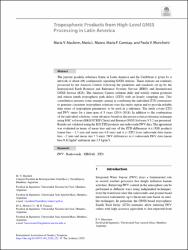Tropospheric Products from High-Level GNSS Processing in Latin America
| dc.contributor.author | Mackern, María Virginia | |
| dc.contributor.author | Mateo, María Laura | |
| dc.contributor.author | Camisay, María Fernanda | |
| dc.contributor.author | Morichetti, Paola Vanina | |
| dc.date.accessioned | 2020-09-11T10:54:53Z | |
| dc.date.available | 2020-09-11T10:54:53Z | |
| dc.date.issued | 2020-07-25 | |
| dc.identifier.citation | Mackern M.V., Mateo M.L., Camisay M.F., Morichetti P.V. (2020) Tropospheric Products from High-Level GNSS Processing in Latin America. In: . International Association of Geodesy Symposia. Springer, Berlin, Heidelberg. https://doi.org/10.1007/1345_2020_121 | en_US |
| dc.identifier.issn | 0939-9585 | |
| dc.identifier.uri | http://repositorio.umaza.edu.ar//handle/00261/1720 | |
| dc.identifier.uri | https://link.springer.com/chapter/10.1007/1345_2020_121 | |
| dc.description.abstract | The present geodetic reference frame in Latin America and the Caribbean is given by a network of about 400 continuously operating GNSS stations. These stations are routinely processed by ten Analysis Centres following the guidelines and standards set up by the International Earth Rotation and Reference Systems Service (IERS) and International GNSS Service (IGS). The Analysis Centres estimate daily and weekly station positions and station zenith tropospheric path delays (ZTD) with an hourly sampling rate. This contribution presents some attempts aiming at combining the individual ZTD estimations to generate consistent troposphere solutions over the entire region and to provide reliable time series of troposphere parameters, to be used as a reference. The study covers ZTD and IWV series for a time-span of 5 years (2014–2018). In addition to the combination of the individual solutions, some advances based on the precise point positioning technique using BNC software (BKG NTRIP Client) and Bernese GNSS Software V.5.2 are presented. Results are validated using the IGS ZTD products and radiosonde IWV data. The agreement was evaluated in terms of mean bias and rms of the ZTD differences w.r.t IGS products (mean bias 1.5 mm and mean rms 6.8 mm) and w.r.t ZTD from radiosonde data (mean bias 2 mm and mean rms 7.5 mm). IWV differences w.r.t radiosonde IWV data (mean bias 0.41 kg/m2 and mean rms 3.5 kg/m2). | en_US |
| dc.language.iso | eng | en_US |
| dc.publisher | Editorial International Association of Geodesy Symposia | en_US |
| dc.subject | IWV | en_US |
| dc.subject | Radiosonde | en_US |
| dc.subject | SIRGAS | en_US |
| dc.subject | ZTD | en_US |
| dc.title | Tropospheric Products from High-Level GNSS Processing in Latin America | en_US |
| dc.type | Parte de Libro | en_US |
| umaza.description.filiation | Fil: Mackern, María Virginia. Consejo Nacional de Investigaciones Científicas y Tecnológicas; Argentina. | |
| umaza.description.filiation | Fil: Mackern, María Virginia. Universidad Nacional de Cuyo. Facultad de Ingeniería; Argentina. | |
| umaza.description.filiation | Fil: Mackern, María Virginia. Universidad Juan Agustín Maza. Facultad de Ingeniería y Enología; Argentina. | |
| umaza.description.filiation | Fil: Mateo, María Laura. Universidad Nacional de Cuyo. Facultad de Ingeniería; Argentina. | |
| umaza.description.filiation | Fil: Mateo, María Laura. Universidad Juan Agustín Maza Facultad de Ingeniería y Enología; Argentina. | |
| umaza.description.filiation | Fil: Camisay, María Fernanda. Universidad Nacional de Cuyo. Facultad de Ingeniería; Argentina. | |
| umaza.description.filiation | Fil: Camisay, María Fernanda. Universidad Juan Agustín Maza. Facultad de Ingeniería y Enología; Argentina. | |
| umaza.description.filiation | Fil: Morichetti, Paola Vanina. Universidad Juan Agustín Maza. Facultad de Ingeniería y Enología; Argentina. | |
| umaza.statusSNRD | Publicada | en_US |
Files in this item
This item appears in the following Collection(s)
-
Ciencias Ambientales, Agroindustrias y de la Tierra [14]
Artículos científicos publicados por equipos de investigación UMaza con resultados de proyectos realizados en las áreas disciplinares: ciencias ambientales, agroindustrias y de la tierra










